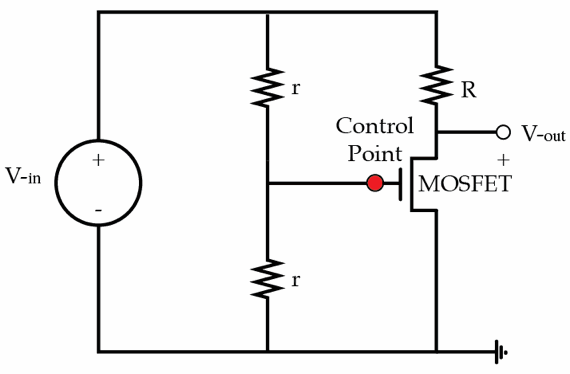MOSFET
Transistors (marked as MOSFET on the circuit diagram) are electronic devices which act as resistors if the voltage applied to their control point is above the threshold voltage, and as switches (open circuit) if the voltage at the control is below the threshold.
You are given a circuit with a MOSFET with the following characteristics: threshold voltage V t = 2 V , resistance if on R o n = 1 0 0 Ω . The voltage on the battery is V i n = 1 0 V , the dividing resistance is r = 5 Ω and the control resistance is R = 5 0 Ω . What is the power in W released on the MOSFET?

Details and assumptions
- Hint: You don't have to do extensive calculations to determine the control voltage
The answer is 0.444.
This section requires Javascript.
You are seeing this because something didn't load right. We suggest you, (a) try
refreshing the page, (b) enabling javascript if it is disabled on your browser and,
finally, (c)
loading the
non-javascript version of this page
. We're sorry about the hassle.
3 solutions
Then suppose the transistor acts as a resistor.
The potential difference between the control voltage ( 5 V ) and source voltage ( 6 3 2 V ) is less than the threshold voltage.
Therefore, the transistor acts as a switch.
Contradiction?
Log in to reply
No, we compare the threshold voltage with the voltage applied to the control point, not the difference between the control point and source voltage.
Basically, once we see a problem like this, our first instinct should be to get rid of the "variables", which basically means, in this context, that we should determine what the MOSFET will do.
Let us first presume that the MOSFET will act as a switch, and we will try to derive a contradiction. Whence, we know that the voltage would be 2 r ( V − i n ) × r = 5 V . Now, the problem statement says that:
switches (open circuit) if the voltage at the control is below the threshold
Since the threshold is 2 V and clearly 5 V > 2 V , we have the desired contradiction.
Now, we have successfully determined that the MOSFET will act as a resistor. Now recall that the power ( W ) released on a resistor is I 2 × R o n (*), where I is the current. So we need to determine I .
Recall once again that the current across equivalent resistor R t is I = R t V . However in the problem, our desired R t is split into R and MOSFET arranged in series, recall that in such a scenario, R t = R o n + R .
Subbing everything back into (*) gives:
W = 0 . 4 4 4
Since the control voltage V C P = r + r V i n r = 2 1 0 = 5 V > V t ( = 2 V ) , the MOSFET is on and acts as a 1 0 0 Ω resistor.
When the MOSFET is on, the current through it,
I = R + R o n V i n = 5 0 + 1 0 0 1 0 = 0 . 0 6 6 6 6 6 6 6 7 A
The power released on the MOSFET,
P = I 2 R o n = 0 . 0 6 6 6 6 6 6 6 7 2 × 1 0 0 = 0 . 4 4 4 W .
Suppose the transistor acts as a switch.
If so, the voltage applied to the control point will be: r + r V i n ∗ r = 5 ( V ) , which is above the threshold voltage.
Therefore, the transistor must act as a resistor.
The current through the transistor is: I = R + R o n V i n .
The power released on the transistor is: W = I 2 R o n = 0 . 4 4 4 ( J ) .